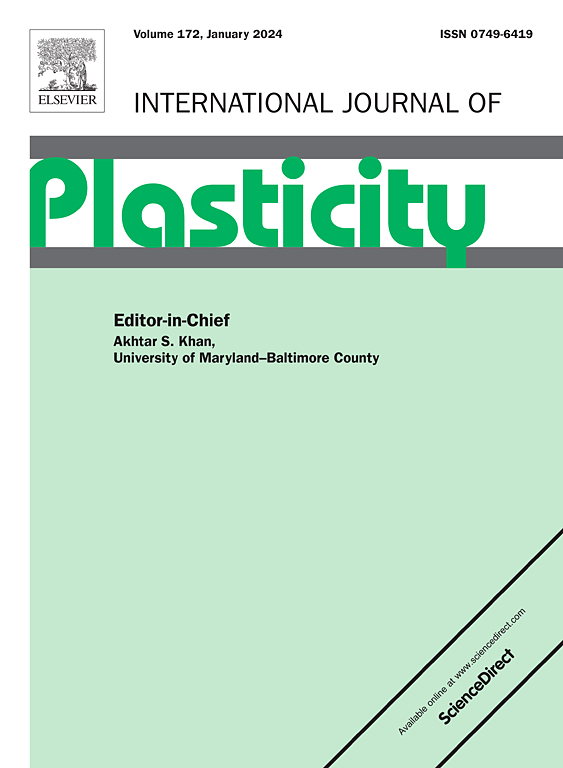Particle pinning effect on grain boundary and double peak-aging characteristic in a hot-extruded Mg-Zn-based alloy
IF 12.8
1区 材料科学
Q1 ENGINEERING, MECHANICAL
引用次数: 0
Abstract
To overcome bottleneck of strength-ductility trade-off is a challenge in Mg-Zn-based alloys. In this work, we develop an age-hardening Mg-1.0Zn-0.1Ca-0.1Al-0.1Mn (wt. %) hot-extruded alloy with better strength-ductility synergy by synergistic heterostructure and nanoprecipitate, exhibiting a tensile yield strength of 352 MPa, an ultimate tensile strength of 413 MPa and an elongation of 15.2 %, respectively. Besides, dynamic recrystallization and dynamic precipitation at different die angles (30° and 90°) and extrusion temperatures (220 °C, 235 °C and 250 °C), and aging precipitation are systematically investigated. Particle pinning effect on grain boundary (GB) considering particle radius and strengthening effects are further clarified. Firstly, under large die angle (90°) and low extrusion temperature (220 °C), typical heterostructure containing recrystallized regions and non-recrystallized regions is achieved due to significant particle pinning effect of nanoscale Ca2Mg6Zn3 and Al8Mn5 particles, and solute dragging effect of Zn and Ca elements on GB. Phase-field simulation and experimental validation showing the evolution of bow-shape GB under significant particle pinning force during the particle-GB interaction. Meanwhile, the phase-field simulations show that the maximum particle pinning force is enhanced as increasing of the particle radius. Secondly, upon ageing at 180 °C, a distinct double peak-aging characteristic emerges in the hetero-structured Mg-1.0Zn-0.1Ca-0.1Al-0.1Mn hot-extruded alloy. The first ageing peak mainly arises from the precipitation of GP zones, while the second ageing peak primarily originates from the co-precipitation of β1’ and β2’ phases. Finally, hetero-deformation induced strengthening, nanoprecipitate-reinforced Orowan strengthening and deformation coordination by twins and non-basal slips contribute to the strength-ductility synergy. These results provide valuable insights for developing high-performance Mg-Zn-based alloys.


颗粒钉住效应对热挤压mg - zn基合金晶界和双峰时效特性的影响
克服强度-延性平衡的瓶颈是镁锌基合金面临的挑战。在这项工作中,我们通过协同异质组织和纳米沉淀开发了一种时效硬化Mg-1.0Zn-0.1Ca-0.1Al-0.1Mn (wt.%)热挤压合金,具有更好的强度-塑性协同作用,抗拉屈服强度为352 MPa,极限抗拉强度为413 MPa,延伸率为15.2%。此外,系统地研究了不同模角(30°和90°)和不同挤压温度(220°C、235°C和250°C)下的动态再结晶和动态析出,以及时效析出。进一步阐明了考虑颗粒半径和强化效应的颗粒钉住对晶界的影响。首先,在大模角(90°)和低挤压温度(220℃)下,由于纳米级Ca2Mg6Zn3和Al8Mn5颗粒的明显颗粒钉钉效应,以及Zn和Ca元素对GB的溶质拖拽效应,形成了典型的含有再结晶区和非再结晶区的异质结构。相场模拟和实验验证表明,在颗粒-GB相互作用过程中,在明显的颗粒钉住力作用下,弓形GB的演化。同时,相场模拟结果表明,随着颗粒半径的增大,最大颗粒钉住力增大。其次,在180℃时效后,异质组织Mg-1.0Zn-0.1Ca-0.1Al-0.1Mn热挤压合金出现明显的双峰时效特征。第一个老化峰主要来源于GP带的析出,第二个老化峰主要来源于β1´和β2´相的共析出。最后,异质变形诱导强化、纳米沉淀增强的Orowan强化以及孪晶滑移和非基底滑移的变形协调促进了强度-延性协同。这些结果为开发高性能镁锌基合金提供了有价值的见解。
本文章由计算机程序翻译,如有差异,请以英文原文为准。
求助全文
约1分钟内获得全文
求助全文
来源期刊

International Journal of Plasticity
工程技术-材料科学:综合
CiteScore
15.30
自引率
26.50%
发文量
256
审稿时长
46 days
期刊介绍:
International Journal of Plasticity aims to present original research encompassing all facets of plastic deformation, damage, and fracture behavior in both isotropic and anisotropic solids. This includes exploring the thermodynamics of plasticity and fracture, continuum theory, and macroscopic as well as microscopic phenomena.
Topics of interest span the plastic behavior of single crystals and polycrystalline metals, ceramics, rocks, soils, composites, nanocrystalline and microelectronics materials, shape memory alloys, ferroelectric ceramics, thin films, and polymers. Additionally, the journal covers plasticity aspects of failure and fracture mechanics. Contributions involving significant experimental, numerical, or theoretical advancements that enhance the understanding of the plastic behavior of solids are particularly valued. Papers addressing the modeling of finite nonlinear elastic deformation, bearing similarities to the modeling of plastic deformation, are also welcomed.
 求助内容:
求助内容: 应助结果提醒方式:
应助结果提醒方式:


